Bulletin – September 2007 Trends in Employment and Labour Supply[1]
- Download 95KB
Introduction
Since the early 1990s, total employment has grown steadily and labour market conditions have progressively tightened. Most recently the unemployment rate has declined to a generational low and the participation rate has increased significantly. This paper outlines several characteristics of the employment growth during this period, and discusses the corresponding decline in nemployment and increase in the labour force participation rate.
Employment Growth
Employment growth has averaged around 2 per cent a year since 1992, which is a little above the average pace achieved during the preceding quarter-century. Compared with earlier periods, annual employment growth has been considerably less volatile, reflecting in large part the absence of a recession since the early 1990s.
Of the 2½ million increase in employment since the early 1990s, almost 50 per cent has been part-time (Graph 1).[2] The high share of part-time jobs in total job creation has continued a trend that has been evident for several decades, and part-time employment is now almost 30 per cent of total employment; over two-thirds of part-time jobs are held by females. In contrast to full-time job creation – which fluctuates with the business cycle – the number of persons working part-time has increased steadily since the 1960s.
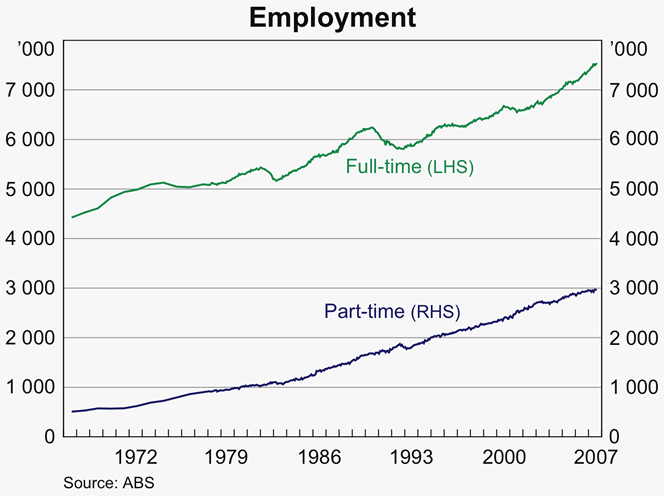
The largest contributions to employment growth have been in the services sectors – where part-time employment is most prevalent – consistent with the ongoing increase in the relative importance of services in the economy (Graph 2). Construction employment has also grown strongly since the early 1990s, and in recent years the pace of employment growth in the mining sector has been rapid, although mining still remains a small share of total employment (around 1¼ per cent). Manufacturing and agricultural employment has been broadly flat for an extended period.
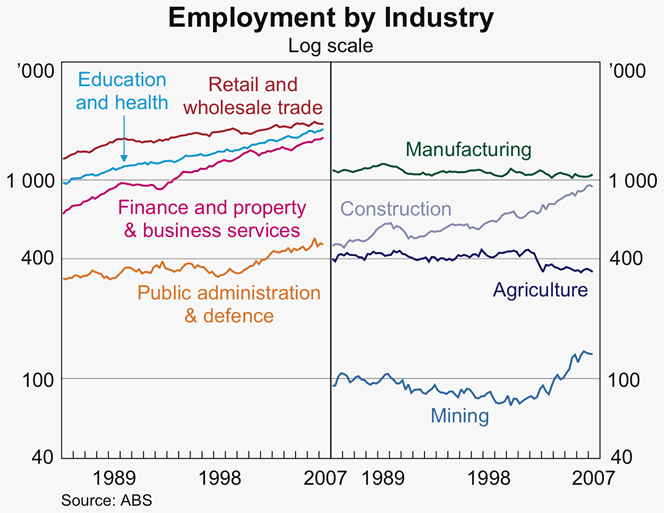
Conceptually, increases in employment can come from growth in the working-age population (persons aged 15 years and above), a higher participation rate and/or a reduction in the unemployment rate. The contribution to total employment from growth of the working-age population has been relatively steady for much of the past decade, picking up somewhat recently with the rise in immigration (see accompanying Bulletin article ‘Immigration and Labour Supply’). The decline in the unemployment rate has made a significant contribution to total employment since the mid 1990s, while the contribution from higher participation has been more important in the past few years (Graph 3). These factors are outlined in the rest of this article.
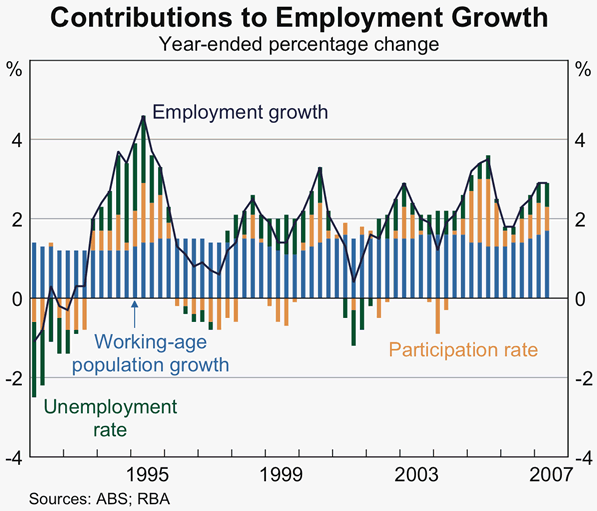
The Decline in Unemployment
After rising significantly during the recession in the early 1990s, the unemployment rate has declined from around 11 per cent of the labour force in 1992 (934,000 persons) to its current rate of around 4¼ per cent (472,000 persons).[3] The largest decline has been for males seeking full-time employment, although the number of unemployed females seeking full-time employment has also fallen (Graph 4). In contrast to persons seeking full-time work – which has a significant cyclical component – unemployment among males and females seeking part-time work has shown comparatively little change through time when measured as a share of the labour force.
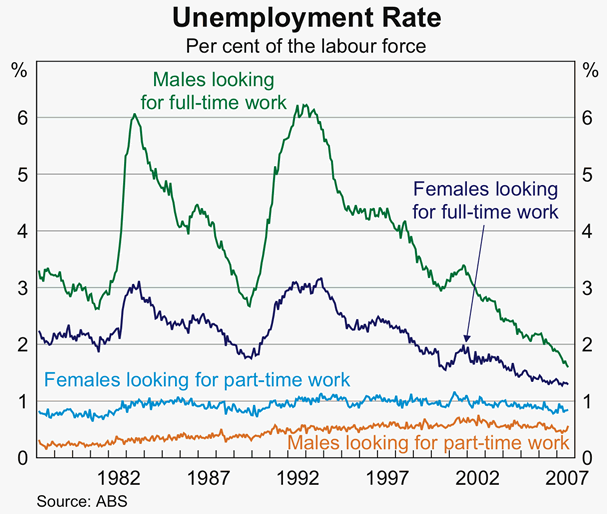
Unemployment is concentrated among those aged between 15 and 24 years; this age cohort comprises around 40 per cent of the total unemployed, although it represents only around 19 per cent of the labour force. Two main factors explain this high share. Part of this age cohort represents students in full-time education seeking part-time work; these persons comprise between ½ to ¾ percentage points of the total unemployment rate and this share has not varied much through the business cycle (Graph 5). Much of the balance reflects the high proportion of this age cohort seeking a full-time first job or young persons who are between jobs. The time it takes for younger workers to find full-time work is especially sensitive to the business cycle, and their number has steadily declined since the end of the last recession (from 3½ percentage points of the total unemployment rate in 1992 to around 1 percentage point now). This sensitivity to the business cycle in part reflects the comparative disadvantage of young persons in terms of their skills and experience.
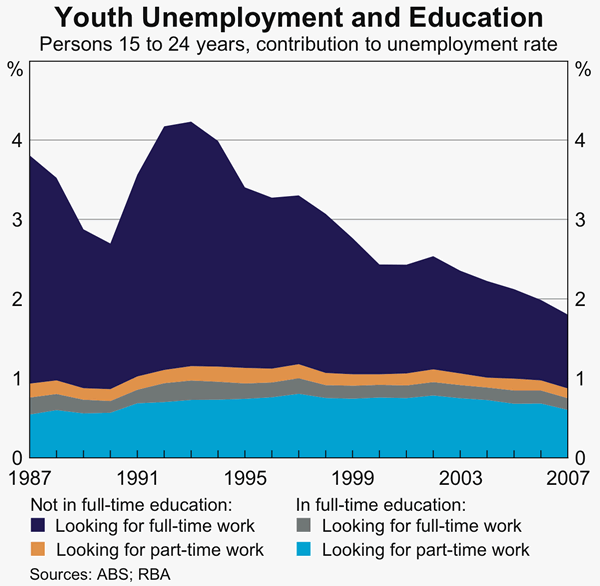
The long-term unemployed (persons unemployed for more than one year) can also be a large share of the total unemployed, especially during recessions; the number of long-term unemployed persons reached almost 4 percentage points of the total unemployment rate in the early 1990s (Graph 6). Long-term unemployment affects all age groups, representing around one-quarter of unemployed youth and up to one-half of unemployment in older age cohorts. Since the end of the early 1990s recession, more than one-half of the total decline in the number of unemployed persons has reflected a decline in the number of long-term unemployed. They now represent only around ¾ percentage points of the total unemployment rate.[4]
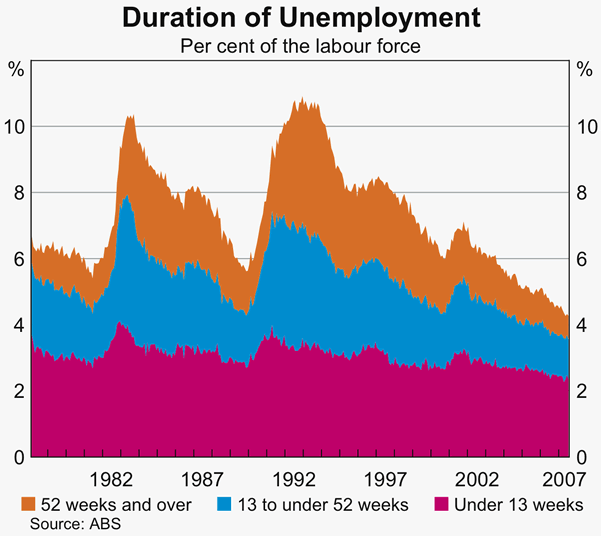
Unlike the long-term unemployed, persons unemployed for fewer than 13 weeks have been a relatively stable share of the labour force over the business cycle. This group largely reflects frictional unemployment and is dominated by persons aged 15 to 24 years (many of whom are in full-time education) and other persons looking for part-time work who are briefly cycling through unemployment. Nevertheless, as a share of the labour force this group has also declined somewhat as the labour market has tightened, reaching a generational low of around 2¼ per cent. The remaining unemployed persons – those unemployed for between 13 and 52 weeks – represent a further 1¼ per cent of the labour force, which is also a generational low.[5]
The Rise in Labour Force Participation
In contrast to the unemployment rate, the national participation rate was broadly stable over the 1990s at around 63½ per cent, although since 2004 it has increased significantly, to its current level of 65 per cent. Participation rates vary over a person's life cycle and across gender. Participation rates for males peak in their early thirties, before dropping off sharply at around the age of 55 years as individuals begin to retire. The pattern of female participation is similar, although their participation dips slightly between the ages of 25 and 34 years as women temporarily leave the labour force to raise young children. The recent 1½ percentage point increase in Australia's participation rate largely reflects three developments: a continuation of the trend increase in the participation rate of women aged between 25 and 54 years; the recent levelling off of the trend decline in the male participation rate; and the rise in participation by persons aged 55 years and over.
Persons of prime working age
The participation rate of prime working-age females – those aged between 25 and 54 years – has steadily increased. Participation of married females in particular has increased strongly for several decades, rising by over 25 percentage points since 1978; in recent years married and unmarried women of prime working age have had similar participation rates (Graph 7).
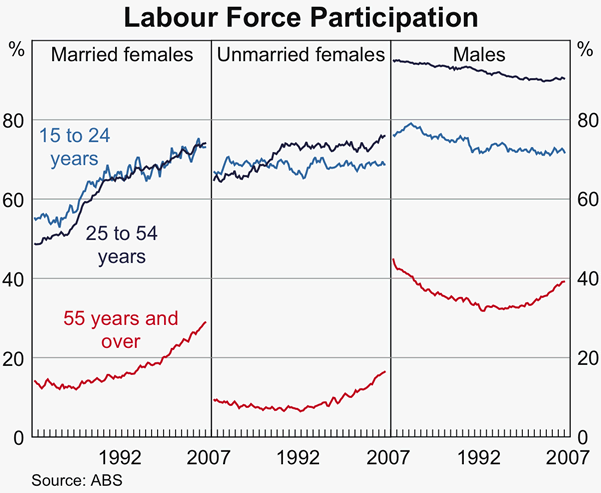
The rising female participation rate over the past 40 years is reflected across the various working-age groups. Compared with earlier generations, successively younger birth cohorts have each had higher participation rates and these have persisted over their entire life cycle. For example, women currently aged between 35 and 44 years (those born between 1962 and 1971) have a participation rate that is almost 20 percentage points higher than women born three decades earlier (Graph 8).
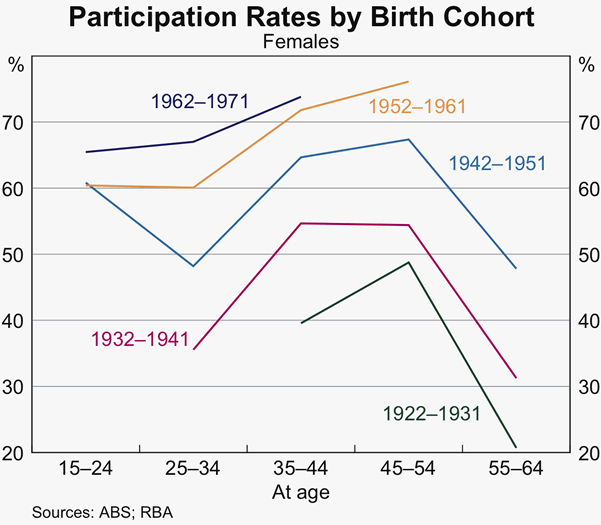
The rise in participation by successive female age cohorts has occurred in conjunction with longer-term structural changes, such as higher rates of educational attainment, lower fertility rates and cultural changes. Associated with this increase, there have been several changes in the structure of the labour market and supporting arrangements – such as access to childcare – although it is not clear whether these factors are a cause or an effect of the growing female labour force. For instance, data from the ABS suggest that the share of children under 12 years who are enrolled in formal childcare has more than doubled over the past 20 years, rising to almost 30 per cent in 2005. In addition, the growing availability of more flexible working arrangements, including part-time work, has enabled more women to enter the work force. Data from the ABS show around 45 per cent of employed mothers used flexible working hours in order to care for a child in 2005, compared with around 30 per cent in 1993.
At the same time, the participation rate of prime working-age males has tended to decline over time and – until the past few years – this decline was sufficient to offset the rising level of female participation. In contrast to females, each successively younger male birth cohort has had a lower participation rate than those who have come before them (Graph 9). The reasons behind this trend are not fully clear, although, at least since the early 1990s, they appear to reflect a higher share of males affected by illness or other disabilities and, to a lesser extent, a rise in the share of males caring for children (Graph 10).[6] These factors have tended to level off in the past few years – especially for disability and illness – and hence the participation rate of prime working-age males has stabilised. Since female participation has continued to rise, this change in male behaviour has contributed to the increase in the national participation rate since 2004.
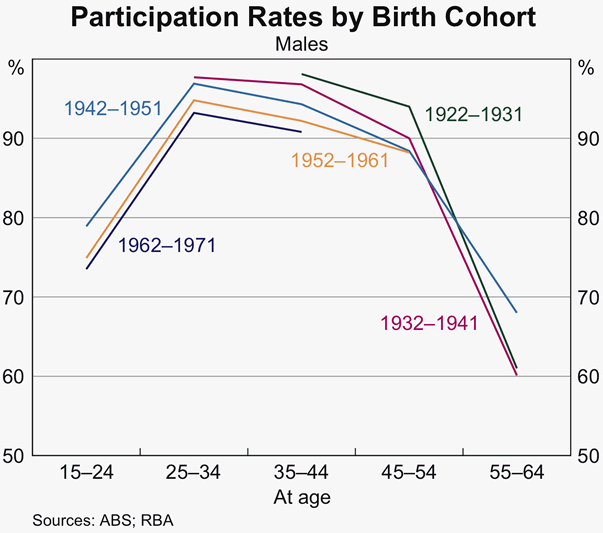

Persons aged 55 years and over
In addition to the rise in participation of prime working-age persons, there have been strong increases in the participation rates of older persons, occurring since the mid 1990s for women and since about 2000 for men. Given that persons aged 55 years and over have a lower participation rate than the rest of the working-age population, the increase in the share of the population in this age group could have been expected to lower the national participation rate. However, the participation rate of this age group has increased so markedly that it has more than offset this effect, accounting for around one-quarter of all labour force growth over the past five years. Data from the ABS suggest that this reflects a significant decline in retirement rates. Specifically, since 1997 the proportion of females and males aged between 55 and 64 years who have retired from the labour force has fallen significantly (Graph 11).
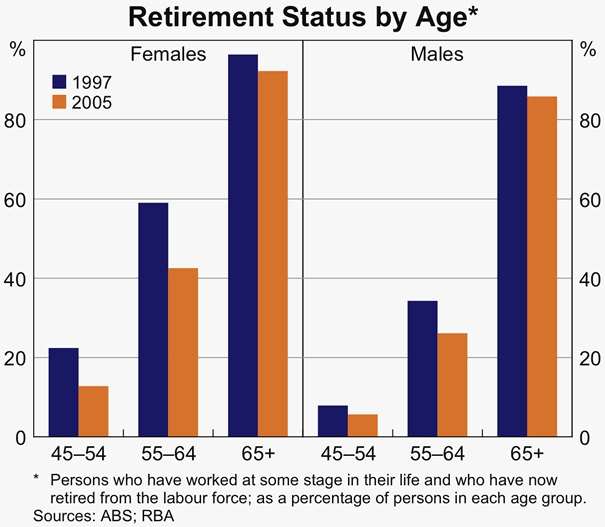
For women, the increase in participation by older cohorts is part of a longer-term pattern shared by most other age groups, as was discussed earlier. For males, the increase in participation by older cohorts appears unusual when compared with other age groups, for which participation has been declining for many years. An examination of age cohorts, however, identifies one notable exception to the pattern of lower participation among successively younger male birth cohorts. The most recent birth cohort to enter the 55 to 64 years cohort (males born between 1942 and 1951) has a significantly higher participation rate at this age than previous generations. Unlike females in this older age group, this response by males currently aged over 55 years does not appear to be a result of a birth cohort with a ‘naturally’ high propensity to participate throughout their life cycle. While the reasons are difficult to know with certainty, this may reflect an endogenous response to the ongoing strong labour market conditions and period of economic expansion. It is also possible that as longevity has increased, some persons are now working longer to save more for a longer period of retirement.
Nonetheless, despite these recent increases, the participation rate of older persons in Australia remains below that of other OECD countries. Australia's participation rate for those aged 55 to 64 years stood at 57½ per cent in 2006, compared with 58½ per cent in Canada, 59 per cent in the UK, 63½ per cent in the US and 73 per cent in Sweden (Graph 12).[7]
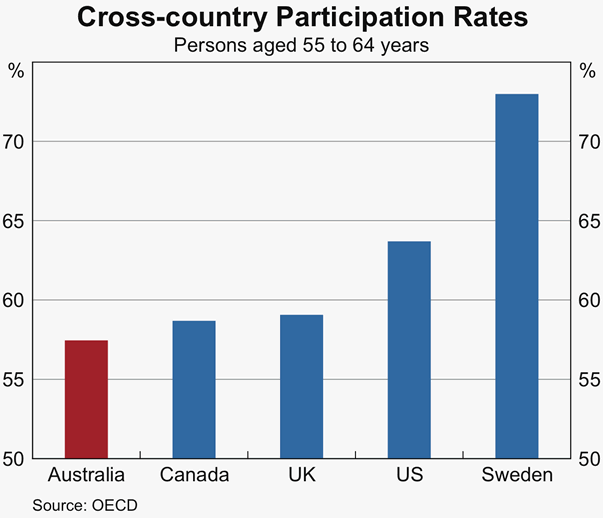
Assessment
The demand for labour has grown strongly since the early 1990s. This demand has in part been met by a large decline in the unemployment rate, especially for young persons seeking full-time employment and the long-term unemployed. In recent years, the strong labour demand has also been met by a rise in the participation rate of older workers, although the stabilisation of participation by prime working-age males and continued increase in participation by females has also been important. Given the current low rate of unemployment, a continuation of the recent trends that have underpinned the rise in the national participation rate would help meet ongoing labour demand. The fact that the participation rate of older persons in Australia remains below that of other OECD countries suggests that further increases may be possible.
Footnotes
This article was prepared by Thomas Betts, Ellis Connolly and David Orsmond of Economic Analysis Department. [1]
Persons working less than 35 hours a week are classified by the Australian Bureau of Statistics (ABS) as part-time. [2]
In line with international standards, the ABS classifies the unemployed as those aged 15 years and over who were not employed in the reference week, had actively sought full-time or part-time work at any time in the four weeks up to the end of the reference week and who were available to start work in the reference week. [3]
It is not possible to know the extent to which this decline reflects a pick-up in the employment prospects of the long-term unemployed, transfers to other welfare benefits such as disability pensions or whether they have permanently exited the labour force due to advanced age, discouragement, or a reluctance to undertake the obligations necessary to continue to receive an unemployment benefit. The ongoing strong labour demand will also have reduced the flow of new entrants into the long-term unemployed cohort. [4]
In addition, around 3 per cent of the labour force are employed persons who are actively seeking additional hours. After rising during the 1990s recession, the number of such workers has declined only slightly during the subsequent economic expansion. Assuming they were all to work an average of 15 additional hours per week (the median preference indicated in ABS surveys), this would be equivalent to a 1 percentage point increase in the level of full-time equivalent employment. [5]
Lattimore R (2007), ‘Men Not at Work: An Analysis of Men Outside the Labour Force’, Productivity Commission Staff Working Paper, Canberra. Rising illness and disability has limited female participation by a similar extent as for males, but this effect on overall female participation has been more than offset by the other factors noted above. [6]
For further information on international comparisons, see Abhayaratna J and R Lattimore (2006), ‘Workforce Participation Rates – How Does Australia Compare?’, Productivity Commission Staff Working Paper, Canberra. [7]